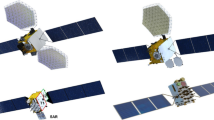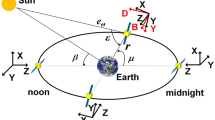Abstract
Japanese Quasi-Zenith Satellite System (QZSS) consists of three inclined geosynchronous orbit (IGSO) satellites as well as a geostationary satellite. According to the QZSS metadata, the three IGSO satellites are equipped with large L-band antennas, which can be assumed as a combination of a circular cylinder and a circular truncated cone. By using the geometrical and optical properties released by the metadata, maximum accelerations of about 5.0 nm/s2, 4.5 nm/s2, and 2.2 nm/s2 can be generated by the side surface of the QZS-1 L-band antenna for the along-track, cross-track, and radial components, respectively. By introducing the so-called box-wing-hat model as an a priori one and estimating parameters of Extended CODE Orbit Model (ECOM), the performances of both precise orbit determination and precise clock estimation can be improved for IGSO satellites. With the a priori box-wing-hat model, the root mean square values of 3D orbit overlapping are 8.5 cm, 27.5 cm, 13.2 cm, and 15.3 cm for QZS-1 in yaw-steering (YS) mode, QZS-1 in orbit-normal mode, QZS-2, and QZS-4, respectively. Satellite laser ranging validation reveals that the standard deviation (STD) values of the a priori box-wing-hat model are 5.6 cm, 5.5 cm, and 5.3 cm for QZS-1 in YS mode, QZS-2, and QZS-4, which are smaller than those of ECOM, ECOM2, and the a priori box-wing model. Regarding the estimated clock offsets, overlapping STD values of smaller than 0.1 ns can be achieved for QZS-1 in YS mode, QZS-2, and QZS-4 by using the a priori box-wing-hat model. Also, the Modified Allan Deviation of the clock estimates can be improved by using the a priori box-wing-hat model for integration time longer than 2000s.








Similar content being viewed by others
References
Arnold D, Meindl M, Beutler G, Dach R, Schaer S, Lutz S, Prange L, Sósnica K, Mervart L, Jäggi A (2015) CODE’s new solar radiation pressure model for GNSS orbit determination. J Geod 89(8):775–791. https://doi.org/10.1007/s00190-015-0814-4
Beutler G, Brockmann E, Gurtner W, Hugentobler U, Mervart L, Rothacher M, Verdun A (1994) Extended orbit modeling techniques at the CODE processing center of the international GPS service for geodynamics (IGS): theory and initial results. Manuscr Geod 19(6):367–386
Boehm J, Niell A, Tregoning P, Schuh H (2006) Global Mapping Function (GMF): A new empirical mapping function based on numerical weather model data. Geophys Res Lett. https://doi.org/10.1029/2005gl025546
CAO (2019a) QZSS satellite property information. Cabinet Office, Government of Japan. https://qzss.go.jp/en/technical/qzssinfo/. Accessed 20 July 2019
CAO (2019b) QZSS operational history information. Cabinet Office, Government of Japan. https://qzss.go.jp/en/technical/qzssinfo/. Accessed 20 July 2019
Dach R et al (2016) CODE analysis center technical report 2015. International GNSS Service: technical report 2015. Edited by Jean Y and Dach R (AIUB), IGS Central Bureau and University of Bern, Bern Open Publishing, pp 25–44, June 2016. https://doi.org/10.7892/boris.80307
Dell’Agnello S et al (2010) Creation of the new industry-standard space test of laser retroreflectors for the GNSS and LAGEOS. Adv Space Res 47(5):822–842. https://doi.org/10.1016/j.asr.2010.10.022
Fliegel H, Gallini T, Swift E (1992) Global positioning system radiation force model for geodetic applications. J Geophys Res 97(B1):559–568. https://doi.org/10.1029/91JB02564
Folkner W, Williams J, Boggs D (2009) The planetary and lunar ephemeris DE 421. IPN Prog Rep 42-178. Jet Propulsion Laboratory
Guo F, Li X, Zhang X, Wang J (2016) Assessment of precise orbit and clock products for Galileo, BeiDou, and QZSS from IGS Multi-GNSS Experiment (MGEX). GPS Solut 21(1):279–290. https://doi.org/10.1007/s10291-016-0523-3
Hauschild A, Steigenberger P, Rodriguez-Solano C (2012) Signal, orbit and attitude analysis of Japan’s first QZSS satellite Michibiki. GPS Solut 16(1):127–133. https://doi.org/10.1007/s10291-011-0245-5
Ikari S, Ebinuma T, Funase R, Nakasuka S (2013) An evaluation of solar radiation pressure models for QZS-1 precise orbit determination. Proc. ION GNSS 2013, Institute of Navigation, Nashville, Tennessee, USA, September 16–20, pp 1234–1241
Inaba N, Matsumoto A, Hase H, Kogure S, Sawabe M, Terada K (2009) Design concept of Quasi Zenith Satellite System. Acta Astronaut 65(7–8):1068–1075. https://doi.org/10.1016/j.actaastro.2009.03.068
Ishijima Y, Inaba N, Matsumoto A, Terada A, Yonechi H, Ebisutani H,Ukawa S, Okamoto T (2009) Design and development of the first Quasi-Zenith Satellite attitude and orbit control system. In: 2009 IEEE aerospace conference. IEEE, pp 1–8. https://doi.org/10.1109/aero.2009.4839537
Johnston G, Riddell A, Hausler G (2017) The International GNSS Service. In: Teunissen PJG, Montenbruck O (eds) Springer handbook of global navigation satellite systems. Springer International Publishing, Cham, pp 967–982. https://doi.org/10.1007/978-3-319-42928-1
Kogure S, Ganeshan AS, Montenbruck O (2017) Regional systems. In: Teunissen PJG, Montenbruck O (eds) Springer handbook of global navigation satellite systems. Springer International Publishing, Cham, pp 305–338
Li X, Yuan Y, Huang J, Zhu Y, Wu J, Xiong Y, Li X, Zhang K (2019) Galileo and QZSS precise orbit and clock determination using new satellite metadata. J Geod 93(8):1123–1136. https://doi.org/10.1007/s00190-019-01230-4
Lyard F, Lefevre F, Letellier T, Letellier T, Francis O (2006) Modelling the global ocean tides: modern insights from FES2004. Ocean Dyn 56(5–6):394–415. https://doi.org/10.1007/s10236-006-0086-x
Meindl M, Beutler G, Thaller D, Dach R, Jäggi A (2013) Geocenter coordinates estimated from GNSS data as viewed by perturbation theory. Adv Space Res 51(7):1047–1064. https://doi.org/10.1016/j.asr.2012.10.026
Montenbruck O, Schmid R, Mercier F, Steigenberger P, Noll C, Fatkulin R, Kogure S, Ganeshan AS (2015a) GNSS satellite geometry and attitude models. Adv Space Res 56(6):1015–1029. https://doi.org/10.1016/j.asr.2015.06.019
Montenbruck O, Steigenberger P, Hugentobler U (2015b) Enhanced solar radiation pressure modeling for Galileo satellites. J Geod 89(3):283–297. https://doi.org/10.1007/s00190-014-0774-0
Montenbruck O et al (2017a) The Multi-GNSS Experiment (MGEX) of the International GNSS Service (IGS)—achievements, prospects and challenges. Adv Space Res 59(7):1671–1697. https://doi.org/10.1016/j.asr.2017.01.011
Montenbruck O, Steigenberger P, Darugna F (2017b) Semi-analytical solar radiation pressure modeling for QZS-1 orbit-normal and yaw-steering attitude. Adv Space Res 59(8):2088–2100. https://doi.org/10.1016/j.asr.2017.01.036
Pavlis N, Holmes S, Kenyon S, Factor J (2012) The development and evaluation of the Earth Gravitational Model 2008 (EGM2008). J Geophys Res Solid Earth. https://doi.org/10.1029/2011jb008916
Pearlman M, Degnan J, Bosworth J (2002) The international laser ranging service. Adv Space Res 30(2):135–143. https://doi.org/10.1016/S0273-1177(02)00277-6
Petit G, Luzum B (2010) IERS conventions 2010. No.36 in IERS Technical Note, Verlag des Bundesamts für Kartographie und Geodäsie, Frankfurt am Main, Germany
Prange L, Orliac E, Dach R, Arnold D, Beutler G, Schaer S, Jäggi A (2015) CODE’s multi-GNSS orbit and clock solution. In: EGU general assembly 2015, 12–17 April 2015, Vienna, Austria
Prange L, Orliac E, Dach R, Arnold D, Beutler G, Schaer S, Jäggi A (2017) CODE’s five-system orbit and clock solution—the challenges of multi-GNSS data analysis. J Geod 91(4):345–360. https://doi.org/10.1007/s00190-016-0968-8
Rodríguez-Solano C, Hugentobler U, Steigenberger P, Bloßfeld M, Fritsche M (2014) Reducing the draconitic errors in GNSS geodetic products. J Geod 88(6):559–574. https://doi.org/10.1007/s00190-014-0704-1
Saastamoinen J (1973) Contributions to the theory of atmospheric refraction. Bull Géod 107(1):13–34. https://doi.org/10.1007/BF02522083
Sośnica K, Prange L, Kaźmierski K, Bury G, Drożdżewski M, Zajdel R, Hadas T (2017) Validation of Galileo orbits using SLR with a focus on satellites launched into incorrect orbital planes. J Geod 92(2):131–148. https://doi.org/10.1007/s00190-017-1050-x
Villiger A (2019) IGS14_2038: update including updated PCO/PV for GPS III satellite G074. IGSMAIL-7733. https://lists.igs.org/pipermail/igsmail/2019/007729.html. Accessed 20 July 2019
Wu J, Wu S, Hajj G, Bertiger W, Lichten S (1993) Effects on antenna orientation on GPS carrier phase. Manuscr Geod 18(2):91–98
Zhao Q, Chen G, Guo J, Liu J, Liu X (2017) An a priori solar radiation pressure model for the QZSS Michibiki satellite. J Geod 92(2):109–121. https://doi.org/10.1007/s00190-017-1048-4
Acknowledgements
We are very grateful to the International GNSS Service (IGS) and the International Laser Ranging Service (ILRS) for providing GNSS and SLR observation data. This study is financially supported by the National Natural Science Foundation of China (Grant No. 41774030), the Hubei Province Natural Science Foundation of China (Grant No. 2018CFA081), and the National Youth Thousand Talents Program.
Author information
Authors and Affiliations
Corresponding author
Additional information
Publisher's Note
Springer Nature remains neutral with regard to jurisdictional claims in published maps and institutional affiliations.
Rights and permissions
About this article
Cite this article
Yuan, Y., Li, X., Zhu, Y. et al. Improving QZSS precise orbit determination by considering the solar radiation pressure of the L-band antenna. GPS Solut 24, 50 (2020). https://doi.org/10.1007/s10291-020-0963-7
Received:
Accepted:
Published:
DOI: https://doi.org/10.1007/s10291-020-0963-7




